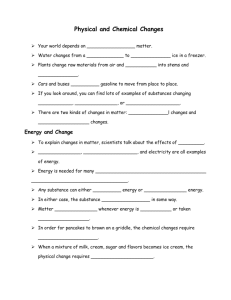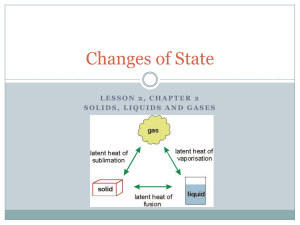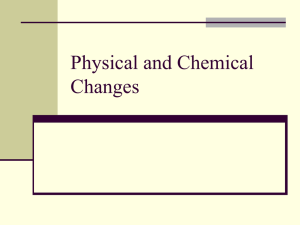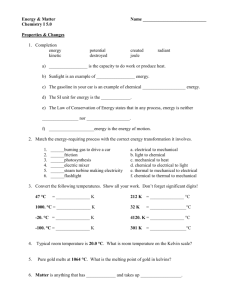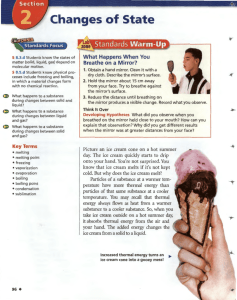Picture an ice cream cone on a hot summer day
advertisement
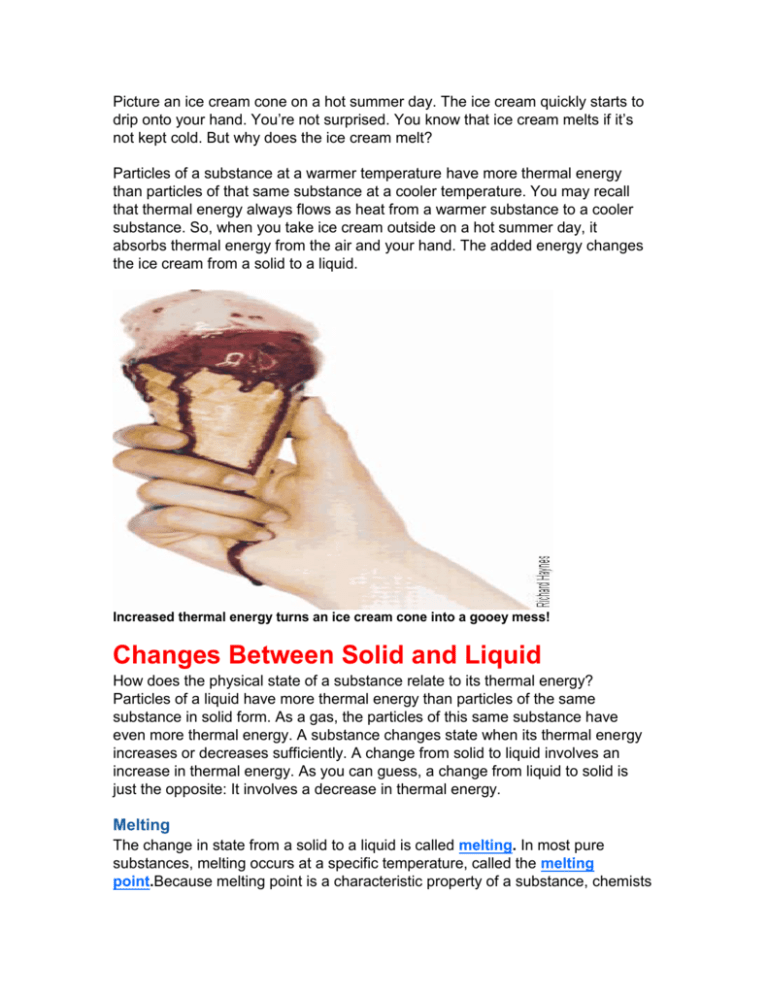
Picture an ice cream cone on a hot summer day. The ice cream quickly starts to drip onto your hand. You’re not surprised. You know that ice cream melts if it’s not kept cold. But why does the ice cream melt? Particles of a substance at a warmer temperature have more thermal energy than particles of that same substance at a cooler temperature. You may recall that thermal energy always flows as heat from a warmer substance to a cooler substance. So, when you take ice cream outside on a hot summer day, it absorbs thermal energy from the air and your hand. The added energy changes the ice cream from a solid to a liquid. Increased thermal energy turns an ice cream cone into a gooey mess! Changes Between Solid and Liquid How does the physical state of a substance relate to its thermal energy? Particles of a liquid have more thermal energy than particles of the same substance in solid form. As a gas, the particles of this same substance have even more thermal energy. A substance changes state when its thermal energy increases or decreases sufficiently. A change from solid to liquid involves an increase in thermal energy. As you can guess, a change from liquid to solid is just the opposite: It involves a decrease in thermal energy. Melting The change in state from a solid to a liquid is called melting. In most pure substances, melting occurs at a specific temperature, called the melting point.Because melting point is a characteristic property of a substance, chemists often compare melting points when trying to identify an unknown material. The melting point of pure water, for example, is 0°C. What happens to the particles of a substance as it melts? Think of an ice cube taken from the freezer. The energy to melt the ice comes mostly from the air in the room. At first, the added thermal energy makes the water molecules vibrate faster, raising their temperature. At its melting point, the particles of a solid substance are vibrating so fast that they break free from their fixed positions. At 0°C, the temperature of the ice stops increasing. Any added energy continues to change the arrangement of the water molecules from ice crystals into liquid water. The ice melts. FIGURE 9Solid to Liquid In solid silver, atoms are in a regular, cubic pattern. Atoms in liquid (molten) silver have no regular arrangement. Freezing The change of state from liquid to solid is called freezing. It is just the reverse of melting. At its freezing temperature, the particles of a liquid are moving so slowly that they begin to form regular patterns. When you put liquid water into a freezer, for example, the water loses energy to the cold air in the freezer. The water molecules move more and more slowly as they lose energy. Over time, the water becomes solid ice. When water begins to freeze, its temperature remains at 0°C until freezing is complete. The freezing point of water, 0°C, is the same as its melting point. FIGURE 10Liquid to Solid Just a few hours in a freezer will change liquid water into a solid. Changes Between Liquid and Gas Have you ever wondered how clouds form, or why rain falls from clouds? And why do puddles dry up after a rain shower? To answer these questions, you need to look at what happens when changes occur between the liquid and gas states. The change from a liquid to a gas is called vaporization (vay puhr ih ZAY shun).Vaporization takes place when the particles in a liquid gain enough energy to form a gas. There are two main types of vaporization— evaporation and boiling. Evaporation Vaporization that takes place only on the surface of a liquid is called evaporation(ee vap uh RAY shun). A shrinking puddle is an example. Water in the puddle gains energy from the ground, the air, or the sun. The added energy enables some of the water molecules on the surface of the puddle to escape into the air, or evaporate. Boiling Another kind of vaporization is called boiling. Boiling occurs when a liquid changes to a gas below its surface as well as at the surface. You see the results of this process when the boiling liquid bubbles. The temperature at which a liquid boils is called its boiling point. As with melting points, chemists use boiling points to help identify an unknown substance. Boiling Point and Air Pressure The boiling point of a substance depends on the pressure of the air above it. The lower the pressure, the less energy needed for the particles of the liquid to escape into the air. In places close to sea level, the boiling point of water is 100°C. In the mountains, however, air pressure is lower and so is water’s boiling point. In Denver, Colorado, where the elevation is 1,600 meters above sea level, water boils at 95°C. FIGURE 11Evaporation and Boiling Liquids can vaporize in two ways Condensation The opposite of vaporization is called condensation. One way you can observe condensation is by breathing onto a mirror. When warm water vapor in your breath reaches the cooler surface of the mirror, the water vapor condenses into liquid droplets. Condensation occurs when particles in a gas lose enough thermal energy to form a liquid. For example, clouds typically form when water vapor in the atmosphere condenses into liquid droplets. When the droplets get heavy enough, they fall to the ground as rain. You cannot see water vapor. Water vapor is a colorless gas that is impossible to see. The steam you see above a kettle of boiling water is not water vapor, and neither are clouds or fog. What you see in those cases are tiny droplets of liquid water suspended in air. FIGURE 12Condensation of Water Water vapor from a hot shower contacts the cool surface of a bathroom mirror and condenses into a liquid. Changes Between Solid and Gas If you live where the winters are cold, you may have noticed that snow seems to disappear even when the temperature stays well below freezing. This change is the result of sublimation. Sublimation occurs when the surface particles of a solid gain enough energy that they form a gas. During sublimation, particles of a solid do not pass through the liquid state as they form a gas. One example of sublimation occurs with dry ice. Dry ice is the common name for solid carbon dioxide. At ordinary atmospheric pressures, carbon dioxide cannot exist as a liquid. So instead of melting, solid carbon dioxide changes directly into a gas. As it changes state, the carbon dioxide absorbs thermal energy. This property helps keep materials near dry ice cold and dry. For this reason, using dry ice is a way to keep temperature low when a refrigerator is not available. When dry ice becomes a gas, it cools water vapor in the nearby air. The water vapor then condenses into a liquid, forming fog around the dry ice. FIGURE 13Dry Ice When solid carbon dioxide, called “dry ice,” sublimates, it changes directly into a gas. Key Terms melting melting point freezing vaporization evaporation boiling boiling point condensation sublimation Reviewing Key Concepts 1. (a) Reviewing What happens to the particles of a solid as it becomes a liquid? (b) Applying Concepts How does the thermal energy of solid water change as it melts? (c) Making Judgements You are stranded in a blizzard. You need water to drink, and you’re trying to stay warm. Should you melt snow and then drink it, or just eat snow? Explain. 2. (a) Describing What is vaporization? (b) Comparing And Contrasting Name the two types of vaporization. Tell how they are similar and how they differ. (c) Relating Cause And Effect Why does the evaporation of sweat cool your body on a warm day? 3. (a) Identifying What process occurs as pieces of dry ice gradually get smaller? (b) Interpreting Photos What is the fog you see in the air around the dry ice in Figure 13? Why does the fog form?

